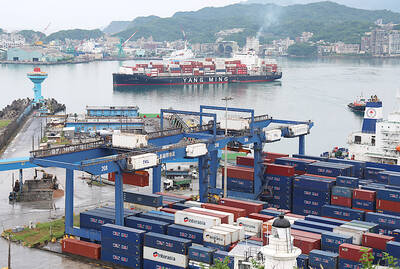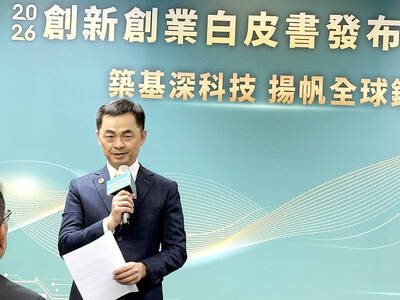Taiwan’s manufacturing sector slid back into contraction territory last month, weighed down by expiring US tariff waivers and volatile exchange rates, the Chung-Hua Institution for Economic Research (CIER, 中華經濟研究院) said yesterday.
The seasonally adjusted manufacturing purchasing managers’ index (PMI) fell 1.4 points to 49.6, below the expansion threshold of 50, signaling a renewed slowdown in industrial activity.
“The decline reflects rising caution among manufacturers as the suspension of US’ ‘reciprocal’ tariff nears expiration,” CIER vice president Wang Jiann-chyuan (王健全) told a news conference in Taipei.

Photo: Hsu Tzu-ling, Taipei Times
Concerns over shipping reliability and delivery lead times also led firms to trim back production and order volume, he said.
Although the PMI remained close to the neutral 50 mark — indicating a subdued rather than sharply declining environment — key components such as export orders and industrial output weakened, pointing to broader sector-wide hesitation, Wang said.
The CIER said geopolitical tensions, particularly between Israel and Iran, drove crude oil prices higher and ended a two-month downtrend in raw material costs for chemical and biotech producers.
However, tepid end-market demand and cautious inventory strategies limited any significant recovery in procurement activity, it said.
Industry performance was uneven, as the electronics, optics and power equipment sectors remained in expansion mode, but textiles, apparel and transportation-related industries contracted, hampered by shifting supply chains and currency volatility, the CIER said.
Wang flagged the appreciation of the New Taiwan dollar against the US dollar as a growing concern, pointing out that each 1 percent rise in the local currency typically erodes corporate revenue or profits by 0.1 to 0.5 percentage points.
Taiwan Semiconductor Manufacturing Co (台積電), the world’s top contract chipmaker, has reported foreign exchange-related losses — a signal that broader impacts could soon ripple beyond the technology sector, Wang said.
Taiwan’s relatively shallow foreign exchange market, with daily turnover of just US$1 billion to US$2 billion, makes it vulnerable to outsized moves, he said, urging central bank intervention to prevent further disruption — especially amid ongoing US tariff negotiations.
In contrast, the nation’s non-manufacturing sector continued to gain momentum.
The non-manufacturing index rose 2.4 points to 54.3 last month, buoyed by a TAIEX rebound and solid commercial property demand — particularly in emerging hubs such as Taipei’s Beitou-Shilin Technology Park (北投士林科技園區), where Nvidia Corp is looking to open new offices and expand operations.
New high-end housing projects and ongoing data center construction fueled a 23.1-point surge in commercial activity for the construction and real-estate sectors, the CIER said.
Financial services also benefited from stronger investor sentiment, Wang said.
However, retail and hospitality remained in contraction despite a strong NT dollar and reduced outbound travel to Japan.
“The seasonal boost we usually expect has yet to appear,” Wang said, citing subdued tourism demand and lower vehicle sales.

CHIP RACE: Three years of overbroad export controls drove foreign competitors to pursue their own AI chips, and ‘cost US taxpayers billions of dollars,’ Nvidia said China has figured out the US strategy for allowing it to buy Nvidia Corp’s H200s and is rejecting the artificial intelligence (AI) chip in favor of domestically developed semiconductors, White House AI adviser David Sacks said, citing news reports. US President Donald Trump on Monday said that he would allow shipments of Nvidia’s H200 chips to China, part of an administration effort backed by Sacks to challenge Chinese tech champions such as Huawei Technologies Co (華為) by bringing US competition to their home market. On Friday, Sacks signaled that he was uncertain about whether that approach would work. “They’re rejecting our chips,” Sacks

Taiwan’s exports soared 56 percent year-on-year to an all-time high of US$64.05 billion last month, propelled by surging global demand for artificial intelligence (AI), high-performance computing and cloud service infrastructure, the Ministry of Finance said yesterday. Department of Statistics Director-General Beatrice Tsai (蔡美娜) called the figure an unexpected upside surprise, citing a wave of technology orders from overseas customers alongside the usual year-end shopping season for technology products. Growth is likely to remain strong this month, she said, projecting a 40 percent to 45 percent expansion on an annual basis. The outperformance could prompt the Directorate-General of Budget, Accounting and

NATIONAL SECURITY: Intel’s testing of ACM tools despite US government control ‘highlights egregious gaps in US technology protection policies,’ a former official said Chipmaker Intel Corp has tested chipmaking tools this year from a toolmaker with deep roots in China and two overseas units that were targeted by US sanctions, according to two sources with direct knowledge of the matter. Intel, which fended off calls for its CEO’s resignation from US President Donald Trump in August over his alleged ties to China, got the tools from ACM Research Inc, a Fremont, California-based producer of chipmaking equipment. Two of ACM’s units, based in Shanghai and South Korea, were among a number of firms barred last year from receiving US technology over claims they have

BARRIERS: Gudeng’s chairman said it was unlikely that the US could replicate Taiwan’s science parks in Arizona, given its strict immigration policies and cultural differences Gudeng Precision Industrial Co (家登), which supplies wafer pods to the world’s major semiconductor firms, yesterday said it is in no rush to set up production in the US due to high costs. The company supplies its customers through a warehouse in Arizona jointly operated by TSS Holdings Ltd (德鑫控股), a joint holding of Gudeng and 17 Taiwanese firms in the semiconductor supply chain, including specialty plastic compounds producer Nytex Composites Co (耐特) and automated material handling system supplier Symtek Automation Asia Co (迅得). While the company has long been exploring the feasibility of setting up production in the US to address